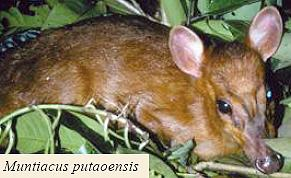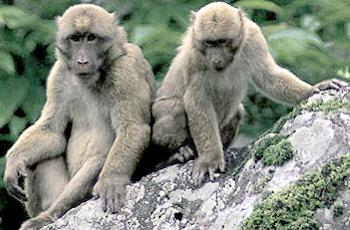 體型最小的鹿、一新的猴類物種、具有滑行能力的青蛙皆羅列於1998年和2008年間,在東喜馬拉雅山所發現的353新物種名單中。但環保人士警告說,這些獨特的動植物正面臨全球暖化而改變其原生棲地的威脅。
體型最小的鹿、一新的猴類物種、具有滑行能力的青蛙皆羅列於1998年和2008年間,在東喜馬拉雅山所發現的353新物種名單中。但環保人士警告說,這些獨特的動植物正面臨全球暖化而改變其原生棲地的威脅。
來自幾十個不同機構的科學家所發現的新物種包括242種植物、16種兩棲類、16種爬行類、 14種魚類、兩種鳥類和哺乳類,和至少高達61種新發現的無脊椎動物。發現新物種的地區從不丹和印度東北部到緬甸最北部,再延伸到尼泊爾和青藏高原(Tibetan plateau)的南部。
世界自然基金會(WWF )負責跳躍的喜馬拉雅山行動(Living Himalayas Initiative)的阿齊茲(Tariq Aziz )表示:「除非設法逆轉氣候變遷的影響,否則這脆弱豐富且多樣化的文化和生物環境將難逃從此消失的命運。」跳躍的喜馬拉雅山行動於8月10日公佈了一項新的報告,將所有的發現成果彙編成「東喜馬拉雅山 -- 兩個世界的衝撞。」
 WWF表示,其中最重要的發現成果之一就是一隻1億嵗的壁虎。該壁虎化石為目前科學界發現最古老的壁虎化石。發掘現場在緬甸最北部喜馬拉雅山地區湖光山谷(Hukawng Valley)的一個琥珀礦場。
WWF表示,其中最重要的發現成果之一就是一隻1億嵗的壁虎。該壁虎化石為目前科學界發現最古老的壁虎化石。發掘現場在緬甸最北部喜馬拉雅山地區湖光山谷(Hukawng Valley)的一個琥珀礦場。
WWF彙編的東喜馬拉雅山面臨的威脅詳細報告包括「由於非法和過度砍伐而造成森林破壞,最終導致洪水;遊耕; 過度採集薪柴;過度放牧家畜;盜獵和野生動物毛皮交易和亞洲使用的傳統中藥材; 採礦;引水和污染;旅遊業;和缺乏妥善計劃的基礎設施,尤其是水壩和道路建設。」
東喜馬拉雅山為全球最易受到全球氣候變遷影響的地區。保育人士表示眼前正在上演的氣候暖化效應在該地區將特別明顯。根據WWF在其報告中援引2009年國際保護協會(Conservation International)的生物多樣性熱點:喜馬拉雅山(Biodiversity Hotspots: Himalayas)的研究結果顯示,「該地區只有25%的原棲地仍維持原貌。」
東喜馬拉雅山目前是10,000種植物、 300種哺乳類、 977種鳥類、 176種爬行動物、 105種兩棲類和269種淡水魚類的棲地。同時,該地區還是密度最高的瀕危孟加拉虎和瀕危較大型獨角犀牛的最後堡壘。
WWF在這份報告中建議,雖然不丹、印度、尼泊爾各國政府對喜馬拉雅山的重要性已有共識,但為有效地實現保育成果,必須串聯整個地區,建立一個3個國家共同努力與分享的遠景和目標。
另外,全球環保團體也建議,「水資源將是一個關鍵性的問題。由於東喜馬拉雅山下游數百萬人賴以爲生的主要河流河面上升,以及其豐富的生物多樣性,為滿足各方的需求,屆時河流管理的規模將無可避免地牽扯到一整個區域,甚或一個河流盆地的範圍。」
閱讀完整「東喜馬拉雅山 -- 兩個世界的衝撞」報告,請點擊這裡。
The world's smallest deer, a new species of monkey, and a flying frog are among the 353 new species that have been identified in the Eastern Himalayas between 1998 and 2008, but conservationists warn that global warming is threatening to alter the native habitats of these unique plants and animals.
The discoveries by scientists from dozens of different institutions include 242 plants, 16 amphibians, 16 reptiles, 14 fish, two birds and two mammals, and at least 61 new invertebrates. The new species were found in a region stretching across Bhutan and northeast India to the far north of Myanmar into Nepal and the southern Tibetan plateau.
"This enormous cultural and biological diversity underscores the fragile nature of an environment which risks being lost forever unless the impacts of climate change are reversed," said Tariq Aziz, leader of WWF's Living Himalayas Initiative, which Monday published a new report compiling all these discoveries, "The Eastern Himalayas - Where Worlds Collide."
One of the most significant findings, WFF says, is a 100 million year old gecko, the oldest fossil gecko species known to science, discovered in an amber mine in the Hukawng Valley in Himalayan regions of far northern Myanmar.
Threats to the Eastern Himalayas detailed in the WWF report include "forest destruction as a result of unsustainable and illegal logging, leading to floods; shifting cultivation; unsustainable fuel wood collection; overgrazing by domestic livestock; illegal poaching and wildlife trade for pelts and traditional Asian medicine; mining; water diversion and pollution; tourism; and poorly-planned infrastructure, especially dam and road construction."
The region is among the most vulnerable to global climate change, which conservationists say will amplify the impacts of these existing threats. "Only 25 percent of the original habitats in the region remain intact," according to the 2009 study "Biodiversity Hotspots: Himalayas" by Conservation International, which is quoted in the WWF report.
The Eastern Himalayas are now known to hold 10,000 plant species, 300 mammal species, 977 bird species, 176 reptiles, 105 amphibians and 269 types of freshwater fish. The region has the highest density of the Endangered Bengal tiger and is the last bastion of the Endangered greater one-horned rhino.
In the report, WWF suggests that to achieve effective conservation, the governments of Bhutan, India and Nepal, who already recognize the importance of the Himalayas at a national level, develop a shared three-country vision for the region as a whole.
The global conservation group advises, "Water availability will be a key concern and, since major rivers rising in the Eastern Himalayas support millions of people downstream as well as the rich biodiversity, so river management will need to take place at a regional, river-basin scale, if it is to meet the needs of all."
Click here to read the full report, "The Eastern Himalayas - Where Worlds Collide."
全文及圖片詳見:http://www.ens-newswire.com/





